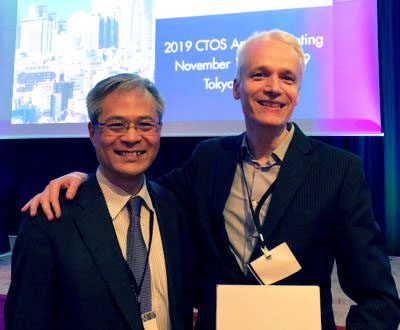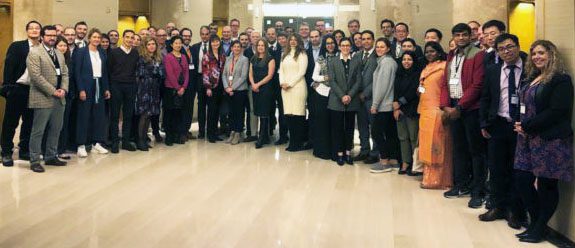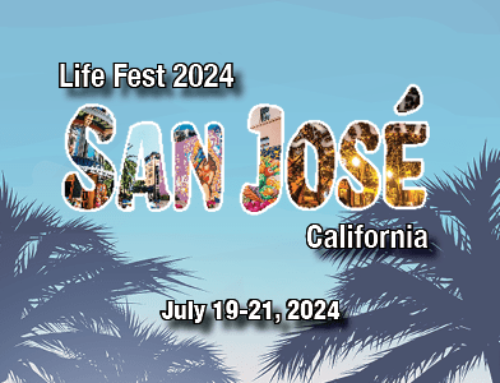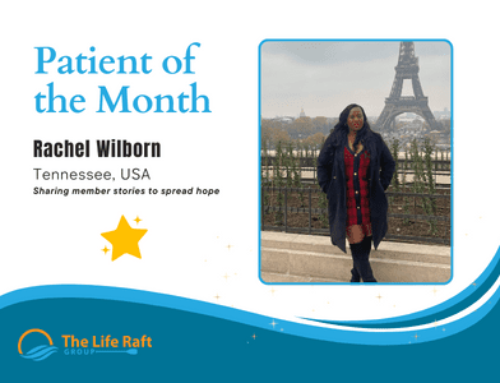Source: Patientenplatform Sarcomen

CTOS, “The Connective Tissue Oncology Society”, is an organization of medical specialists and researchers who specialize in bone and soft tissue tumors. They hold a meeting every year to discuss the latest innovations in this area. This year the meeting took place in Tokyo from November 13 until 16.
The field of sarcoma tumors is very complex and diverse: one of the presentations focused on the new classification of sarcoma tumors by the World Health Organisation, which discerns over 200 subtypes!
One of the sessions in the scientific program was devoted entirely to GIST and covered some of the newest developments in GIST research.
GIST tumors arise from the supportive tissue of the gastrointestinal tract and are most frequently occurring in the stomach. Today’s first-line treatment consists of Imatinib, the second line is Sunitinib and the third line is regorafenib. To date, no therapy was available for patients who showed progression under regorafenib and for patients with some special mutations like PDGFRα D842V.
The first presentation was given by Dr. Margaret von Mehren (Fox Chase Cancer Center). She presented the results of the “Invictus” study which investigated whether the use of ripretinib can give survival benefits in these groups. Ripretinib is an oral inhibitor of GIST tumors with a KIT or PDGFRα mutation that are imatinib resistant. Median progression-free survival was found to be significantly better in the group treated with ripretinib compared with the placebo group. The median survival was also significantly better in the ripretinib group (15.1 months with ripretinib, versus 6.6 months in the placebo group). The side effects were also relatively limited. Ripretinib could possibly become the new gold standard treatment for GIST tumors that are progressive beyond the 3 standard lines. Actually, ripretinib is also being studied in second line (i.e. directly after imatinib) in the ongoing “Intrigue” study.

President and Program Chair Dr. Akira Kawai and Dr. Robin L. Jones
The second study, presented by Michael Heinrich (OHSU Knight Cancer Institute), concerned avapritinib, a selective inhibitor of KIT and PDGFRα. This study included patients who had a PDGFRα mutation or who had already received at least three lines of treatment. Results showed response in 86% of patients with a PDGFRα mutation. In the other group, the overall response was 22%. Avapritinib, therefore, exhibits important anti-tumor activity in a group of patients for whom no other medication has been available until now. It is possible that Avapritinib can also be used as an earlier line of therapy, but this requires further studies in which a comparison is made with a control group.
The phase 2 study, “Cabogist”, investigates the use of Cabozantinib as a third line therapy (i.e. directly after imatinib and sunitinib). The study, which was presented by Patrick Schöffski (University Hospital Leuven) reached its primary endpoint, namely a progression-free 12-week survival of 58%. The median progression-free survival was 6 months. This suggests a slightly better performance than regorafenib, the actual third line therapy for GIST. The final results of the study, including a molecular analysis, are still ongoing.
The last presentation which was given by Jorge de la Torre Medina (University of California San Diego) and discussed a research project that investigated the relationship between the location of primary GIST tumors in the stomach with the mutation. The results show that indeed there is a correlation between location and mutation: in the fundus (upper) part of the stomach mostly tumors with KIT mutations are found, whereas in other locations we see a mix of various mutations.
In addition to this session that focused on new developments in GIST research and treatment there was a so called “Sunrise in Tokyo” session on Saturday morning which covered the basics of GIST pathology, surgery and systemic therapy and which aimed at educating young doctors. The session started at 6:15 am and lasted until 7:30 am.
Finally, there was a presentation “Larotrectinib in TRK fusion sarcomas”. TRK fusion cancer occurs when the NTRK gene fuses with another gene. This leads to overproduction of a new TRK protein that stimulates the growth of tumor cells (oncogenic driver). TRK fusions can occur in many different cancers including a few sarcomas. In GIST this type of gene fusion is extremely rare.
Larotrectinib, a TRK inhibitor, is a drug with strong activity in patients with a TRK fusion. In the meantime, the drug has also been approved by the FDA (Food and Drug Administration) for this group of patients.

Transatlantic Australasian Retroperitoneal Sarcoma Working Group. (A collaborative group for Surgical Oncologists and Sarcoma Professionals which met at CTOS this year.)




